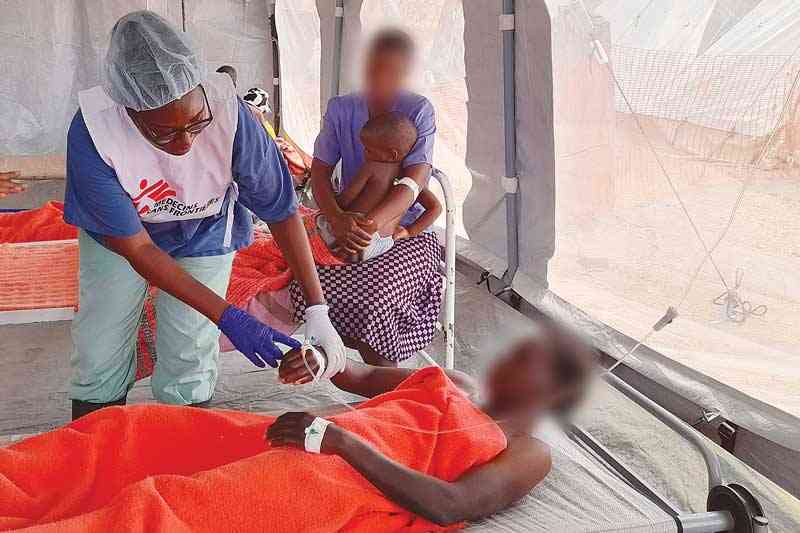
WINFILDA Shonhai (31) from Buhera district in Manicaland province recounts the day a cholera outbreak hit her home.
“I started vomiting in the wee hours of one Monday morning and never suspected that it was cholera,” she said.
As if that was not enough, nine family members were admitted to Zangama Clinic in rural Buhera, where cholera has been ravaging the community since August.
Although she had heard of cholera, Shonhai never imagined the disease would visit her family.
She admits that she used to think that the diarrhoeal disease only affected the urbanites.
The family members were reluctant to visit the clinic, but when the situation deteriorated, after continuous vomiting and excessive diarrhoea, Shonhai’s husband sought help and rushed the family to the clinic about 20km away.
Upon arrival at the clinic, her husband was also admitted as he started showing symptoms of cholera.
The whole family was admitted to a cholera treatment centre set up by Medecins Sans Frontieres (MSF) at Zangama Clinic, with each member at a different stage of recovery.
- Chitungwiza sewer infrastructure collapses
- Chitungwiza sewer infrastructure collapses
- LSU runs dry, students resort to open defecation
- Malawi cholera death toll crosses 1,300: health official
Keep Reading
“I suspect we got cholera from one of our family members who had visited another village,” she said.
“To get the whole family infected was the worst nightmare. I was the first one to recover and I am happy my family members are recovering. We almost died, the pain was surreal, but the care and support we got from the nurses resuscitated us.”
Shonhai is one of the more than 2 500 confirmed cholera cases in Zimbabwe since February 2023.
There has been a cumulative total of 8 087 suspected cholera cases, 51 laboratory confirmed deaths, 152 suspected cholera deaths and 1 241 laboratory confirmed cases as of November 19.
Buhera district has been declared the major hotspot, with the cholera outbreak being linked to apostolic sect gatherings where personal hygiene is alien.
After the first case was reported in Chegutu, Mashonaland West province in February, the disease spread across the country’s 10 provinces.
MSF is currently camped in Buhera to offer support to affected villagers.
According to MSF, the main driver of cholera in Buhera is lack of safe water, with villagers relying on water drawn from a potentially contaminated river.
“The MSF team in Buhera is providing technical support in proper construction and layout of the cholera treatment centres, providing nursing mentorship at different clinics, logistical support, case management, strengthening infection prevention and control measures and risk communication and community engagement and health promotion” MSF country medical representative Kuziwa Kuwenyi said.
About six cholera treatment centres have been set up in the district by MSF through the Health and Child Care ministry.
The organisation also donated cholera beds and basic medical supplies like ringer’s lactate (used to treat dehydration and restore fluid balance in the body) and oral rehydration solution.
“We are conducting awareness sessions on cholera across the district, especially where there are gatherings and also targeting the apostolic sect members who do not seek medical attention when infected with cholera,” MSF health promotion and risk communication and community officer Onwell Nyekete said.
“The sessions cover important topics such as what cholera is, how it spreads, what the preventative measures are, and how to detect the symptoms so they can report it. This is crucial information that can help people act if they suspect they, or someone they know, might have cholera.”
Health and Child Care ministry’s director for epidemiology and disease control Rudo Chikodzore said the ministry was taking measures to contain the cholera outbreak.
“As part of the cholera response, the environmental health teams are conducting contact tracing in affected communities to facilitate early detection and treatment.
“Cholera treatment centres have been set up at health facilities in affected communities while oral rehydration points have been set up in villages closer to the community,” Chikodzore said.
“Medicines and commodities for case management have been mobilised using a multi-sectoral, multi-stakeholder approach resulting in resources for immediate response being availed earlier.
“Risk communication and community engagement are also ongoing.”
Zimbabwe has been battling recurring cholera outbreaks, with the responsible authorities failing to contain the disease since 2008.
Meanwhile, authorities in Zimbabwe are currently seized with fighting cholera, that is fast turning into a deadly outbreak, especially in Harare — a traditional hotspot.
Addressing journalists at a training workshop recently, Harare City health department’s epidemiologist Michael Vere said several factors were making it difficult to eradicate cholera in the capital.
He said the outbreaks originate from the main water source, Lake Chivero, which is highly polluted.
“As a result of that (high pollution), cleaning the water is now very expensive, requiring millions of United States dollars. The city is producing a third of the required water,” Vere said.
“The chemicals are expensive. Residents are billed in local currency, yet chemicals are purchased in US dollar terms. Major sewer bursts occur, with a perennial burst in Glen View requiring US$16 million to repair.”
While all necessary measures to deal with the effects of the deadly disease are being taken, people in recently affected areas are getting help to get rid of the disease.
In Buhera, the Shonhai family is elated that the gods of life are still conscious about their existence.
Of all the nine infected members, none succumbed to the disease.
“It was a traumatic experience, a painful moment filled with anxiety, but we are happy to be alive,” Shonhai said.











